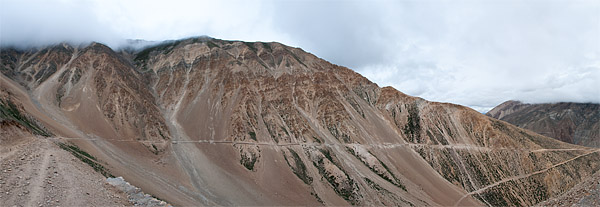Saturday, 18 July 2009
Kathmandu, Bagmati, Nepal
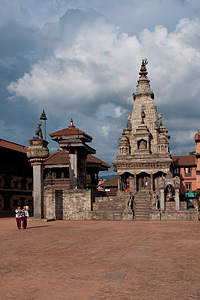
(Bhaktapur, Bagmati, Nepal)
After ten uncomfortable hours trying, but failing, to sleep on a plane we found ourselves at Delhi airport we found ourselves with three hours wait. I had been waiting to go to Mount Kailash for five years but through a combination of work and politics had not managed it. On the work side the last two years had been very busy getting back up to speed in investment banks after an eight year break. I choose Lehman Brothers to make my return with the spectacular result that it collapsed in September 2008. However I had the good luck to be in part of the bank bought by Nomura and had been working furiously since then to build a new computer system. Having had no holidays since Christmas I decided that I desperately needed to unwind and with our project pretty much in the bag had booked three weeks off.
On the political side the Maoists in Nepal under Prachanda had agreed to a cease fire in 2006 after ten years of civil war and had entered into politics. Earlier in 2009 the Maoist had walked out of the government and the peace had looked shaky but in July they grudgingly returned to parliament. In China there had been a lot of unrest in Tibet in 2008 before the Olympics and it had been closed to tourists for the whole season. Just before we were about to leave there was another eruption of unrest but this time amongst the Uighurs, the Muslim inhabitants of Xinjiang province which we had visited eleven years earlier and was next door to Tibet. The Chinese had clamped down but fortunately had left Tibet open. Auspiciously everything in our lives and the local politics had finally aligned to permit this trip. Thus there we were one sticky Saturday in July, stuck in Delhi airport with a three hour wait for a transfer to Kathmandu. But after five years waiting what was another three hours!!
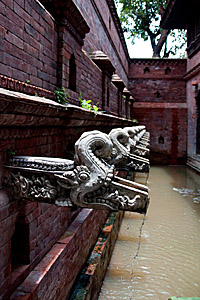
(Kathmandu, Bagmati, Nepal)
To kill the time I had bought a book called the "Lost City of Z" with me, a rip roaring account of the disappearance of Percy Fawcett and his son in the Amazon in the 1920's and the subsequent attempts of people to find him. The tale itself was fascinating as over a hundred people died in the various rescue missions and naturally he was never found. Also fascinating was the exploration of whether the inhospitable Amazon could have ever supported a city like Fawcett's Z or El Dorado. True the book was not about Tibet but then I had already read several books about people attempts to explore Tibet at the same period in time.
The flight took a couple of hours. Depressingly for Anna we were going to fly for two hours East of Delhi only to fly almost all the way back to get to West Nepal a few days later. However we had to get our passports to Kathmandu to obtain both our Nepalese trekking permits and Chinese visas. Coming into Kathmandu we were presented with the lush vista of heavily forested ridges and torrents of water streaming down from the Himalayas. It was clear why the Kathmandu valley is so heavily populated. At 1300m it is much cooler than the plains yet low enough that it apparently never snows. People inevitably build mental pictures of what places would be like and for me I was expecting Kathmandu to be perched on an outcrop surrounded by towering, snowy peaks. The truth is that it is in a broad valley and (due to pollution) the mountains can very rarely ever be seen.
Our hotel Node: link was a charming boutique hotel positioned quite close to the airport. This turned out to be a fortunate decision as getting around in Kathmandu's traffic is not, as we were to find out, fun. However that day it meant that we could virtually jump put of the plane and into the hotel's swimming pool to cool down. We spent the rest of the afternoon by the pool then had a six course dinner in the hotel's excellent and very traditional Newari restaurant.
Sunday, 19 July 2009
Kathmandu, Bagmati, Nepal
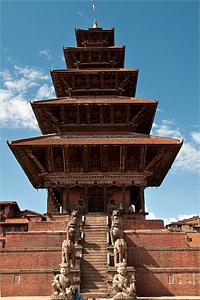
(Bhaktapur, Bagmati, Nepal)
We were stuck for 72 hours in Kathmandu. Stuck sounds like an awful thing to say but as soon as we stepped outside our hotel, a veritable oasis of calm, it became obvious that years of over development had not been very kind on the place. Our first two chores of the day were dropping our passports with the trekking agency and visiting the bank to get some cash. This took a lot longer than expected and it was not until about 1300 that we were ready to set off for our first site seeing destination Bhaktapur.
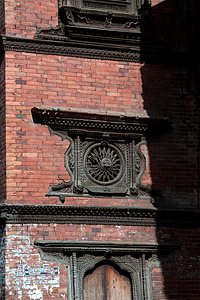
(Bhaktapur, Bagmati, Nepal)
This is where we started to experience Kathmandu's traffic problems. Bhaktapur was no more than six kilometres from the central bus terminal yet the trip took well over an hour. True the road was in the process of being rebuilt with the help of the Swiss government yet the amount of traffic was insane. However when we finally did arrive it was well worth the effort. Along with the kingdoms Kathmandu and Patan (now little more than a suburb of the former) Bhaktapur ruled the valley and for a brief spell in the 15th century was the capital of Nepal. Unlike Kathmandu however it had not been wrecked and its central core of brick paved streets and buildings has been preserved as a UNESCO world heritage site.
After a short walk from the bus stop we found ourselves entering the town's durbar square which consisted of a series of temples, palaces and pagodas laid out around a brick plaza. We had not had any lunch so decided to zip through to Taumadhi Tol Square which was smaller and had a charming pagoda which had been converted into a restaurant with tables for two surrounding its upper balcony. I had a spicy paneer dish in the belief that spicy food is least likely to contain bugs despite the fact that it has a similar effect on the digestive tract. Bhaktapur is known for its New Year celebration, or Bisket, when huge chariots are wheeled through the town. The wheels of the juggernauts (this is where English gets the word from) lay besides a small shrine in the square below us.
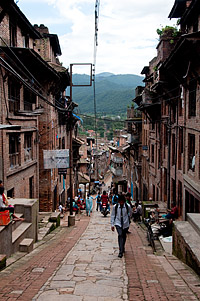
(Bhaktapur, Bagmati, Nepal)
Bhaktapur is also well know as a centre of crafts so our next stop was another square to look at woodworking shops and a few Thangka studios. Here we singularly failed to buy anything despite the fact that we would not have any opportunity after our trek. The truth is psychologically you cannot buy any souvenirs in the first days of your holiday, which is stupid given that a few weeks in a country does not make you any less likely to get ripped off. In retrospect we should have bought a Thangka as we were there in low season and in one place were offered what constituted a weeks work for a skilled craftsman for $150. The woodwork was a different story, we were looking for a piece of a specific size and not finding it we were able to walk away without any feelings of retail regret.
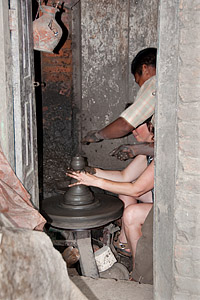
(Bhaktapur, Bagmati, Nepal)
We had more luck exploring the streets. Bhaktapur, courtesy of an entrance fee, was very well preserved and thankfully traffic free. The town's inhabitants lived in the most incredible brick buildings with very intricate wood carved window and door frames. Our hotel in fact contained many examples of the finest work rescued by its founder from a modernising Kathmandu, however it was nice to see Nepalese buildings as they once were and in situ.
At one point we turned off the main tourist trail and walked through the back streets. Although the buildings here were interspersed with the odd concrete construction the charm of the place was not diminished. Soon we found ourselves in Potters square where Anna was offered an impromptu lesson. The great thing about Bhaktapur in the low season is that there were few aggressive guides/hawkers around. As our guide out it the place was like Kathmandu had been when found by tourists in the sixties. We then went back to Burbar square and attempted to get some photos despite the raking light, and then walked back to the bus stop. Here we balked at the thought of another hour in traffic so attempted to find a taxi. This took some haggling, the price started at 600 Rs, went up to 1000 when we told them where we were staying, then dropped back to 600 Rs when we walked off.
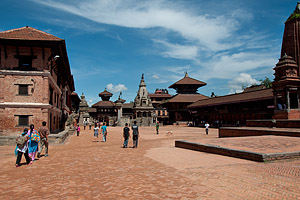
(Bhaktapur, Bagmati, Nepal)
Coming back through a near continuous traffic jam we got a view of what development had done to Kathmandu. The setting sun back lit a fig of brown pollution which just squatted over the top of the city. It is said the city is the world's second most polluted after Mexico City and indeed a lot of residents and the entire police force wear face masks when in the streets. As I mentioned before it is definitely not the Shangri-la of most people's imaginations.
That night a torrential storm hit the town. Being the monsoon season it rained practically every evening we were there. We ate in Thamel at a restaurant with pretensions of being gourmet, sitting under an awning watching the rain. It being Kathmandu eventually the power cut out and we were treated to a candlelit supper watching the electrical storm rage overhead. The highlight of the meal was Himla, a local wine of fermented raspberries which makes an excellent dessert wine.
Monday, 20 July 2009
Kathmandu, Bagmati, Nepal
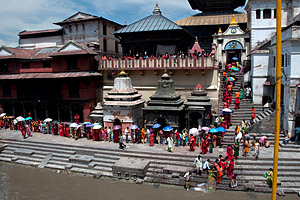
(Kathmandu, Bagmati, Nepal)
We had decided to spend the morning at Pashupatinath the oldest Hindu temple in Kathmandu and apparently the spot where Shiva, wanting to escape the other gods, escaped to from his palace on Mount Kailash. Fortunately it was a short walk from out hotel at a curve on the Bagmati river. As soon as we walked out of our hotel we were surrounded by hordes of people dressed in red and orange. We decided to go with the flow and were funnelled through a park along a path lined with stalls selling flowers and other dedications.
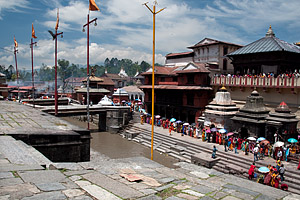
(Kathmandu, Bagmati, Nepal)
Non Hindus were not allowed into the main shrine so, after paying an entrance fee, we skirted it and found ourselves by the banks of the river near the Ghats. Hindu custom is to cremate their relatives by the banks of a holy river washing the ashes away in the stream. We had seen people being taken for cremation before but never the funeral pyres themselves. When we arrived three pyres were already burning and a group of mourners were gathering around an unlit fourth. We walked up the river a bit and on the way back the family were just putting the body on the pyre. Whilst it seems a bit odd that we would watch, scores of people were gathered and watching much more intently. The eldest boy of the family lit the pyre but, not particularly wanting to see the process, we ducked out.
We headed for some terraces opposite the royal Ghats. It was here that King Birendra and Queen Aiswarya were cremated after they were massacred by their son in 2001 after he had been sent to bed for being drunk at a party. At this point however it was a much more joyous affair. Hundreds of worshippers, mostly women, lined the staircase waiting to get into the sanctuary. Another favourite pass time seemed to be trying to drop coins onto the top of a small shrine which held a statue of Shiva. On the terraces overlooking this spectacle we also encountered several Sadhus who were very keen to have their photos taken. Through sheer intolerance of tourist norms we did not bother here and at the many sites where they proliferated through Kathmandu.
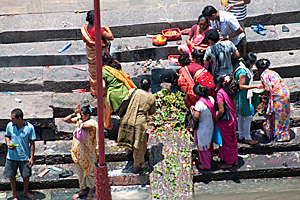
(Kathmandu, Bagmati, Nepal)
After a bit we decided to walk over the hill to Golkinarth. We passed through a huge array of Shiva shrines and down the other side of the hill. There was not a lot to be seen here, apart from the spectacle of some sky diving monkeys which, for the great amusement of all around, were climbing trees and diving from some ten or twenty metres into a small pool. We then followed the river back and found ourselves once again at the terraces overlooking the ghats, from where we returned to the hotel.
Here we recuperated with a swim in the pool and an hour or so in the sun before heading out to central Kathmandu. We had a small list of optional extras which we had decided to buy there and had wanted to sample the central Durbar square, both these ideas turned out to be huge mistakes. Firstly there were a huge array of fake North Face jackets but the thermals I sought were nowhere to be found. As we headed further down Jaytha Thamel the shopping got more and more and more local and the streets very narrow. We reached a point where it was so crowded that we were almost going to turn back but then finally emerged into Indra Chowk.
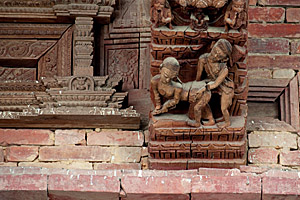
(Kathmandu, Bagmati, Nepal)
Words cannot explain the streets of Thamel and what came afterwards in Durbar square. Imagine being hemmed in by a small alleyway six people wide with people rushing past you. Then add to this picture motorbikes, not just one or two, oh no, but a continual barrage of them trying to push past. In Durbar square, despite being more open this did not cease despite the fact that we had to pay a 200 Rs entry fee. In fact it was just supplemented with a never ending stream of "guides", saddhus and coin sellers all hanging on your every breath.
In short Kathmandu's Durbar Square is to be avoided at all costs. The sites are covered in pigeons and even if they were not you could not escape the throngs long enough to enjoy them. We sacrificed our entry fee, walked straight out and jumped into a taxi to go back and freshen up before dinner, We had intended this to be at the hotel Yak and Yeti, a Kathmandu institution which according to our guide book had a decent Nepali restaurant. Sadly however it had closed so after searching around for a while we went to the Kaiser Mahal gardens. This was a folly constructed by Nepal's Rana family which had been refurbished as a restaurant by our hotel. The setting was lovely but sadly the food was a bit average. We got back to the hotel early and fell into a deep sleep.
Tuesday, 21 July 2009
Nepalgunj, Bheri, Nepal
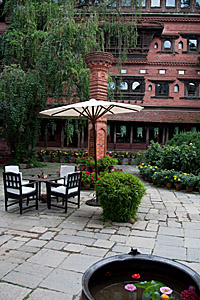
(Kathmandu, Bagmati, Nepal)
The start of our trip to Tibet. The first hop was to be an internal flight from Kathmandu to Nepalgunj in Nepal's South West corner, We had already decided that rather than trying to squeeze in another temple we would pack leisurely and then relax in the gardens of our hotel for the AM. Not a lot to report here however as the hour of our departure approached the clouds started to blacken and thunder began rumbling. Anna, not the best of fliers anyway, started to have strong doubts about being able to get on the airplane. When finally our ride to the airport arrived these doubts condensed into a fully fledged fear. However to her credit, after a bit of coaxing, she managed to board the twenty seater airplane.
The flight was quite smooth in comparison to our flight from London to Delhi and the landing almost perfect. However that is more than could be said about our guide - Rikzin. It was 36 degrees at the airport and we were greeted by a very hot and bothered Rikzin who informed us there were no planes going to Simikot and we would need to fly from Surket some 6 hours away by car. As it turned out it probably would have been a good move as more planes flew from Surket to Simikot and we later found out that there had indeed been no planes heading our way for a couple of weeks. However we were a bit concerned about the change of plan and after some confusing exchanges Rikzin's mobile rang and we were finally informed that there would be a flight after all. We then hopped into a van and went to our hotel to settle down for the night.
The Sheena hotel was an unusual place, immaculate gardens but a very run down interior. The one saving grace of our room was a working air conditioner. We chilled out for a bit whilst our guide went into town to get supplies, then sat and had dinner with him on the front lawn. The mosquitos nibbled us a bit but in the sweltering heat we concluded that the garden was the best place to be.
Wednesday, 22 July 2009
Simikot, Humla, Nepal
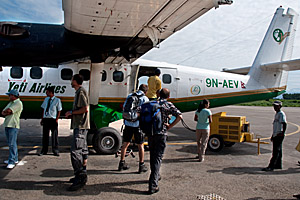
(Nepalgunj, Bheri, Nepal)
We woke up at 0530 and after a quick shower and a bit of breakfast headed to the airport. The time of our departure was not pre-ordained as it was governed by the cloud cover of our destination, Simikot , deep in a valley in the Himalayas. We turned up at the airport around 0700 and begun the slow process of check-in and security. This seemed to be purposefully staggered to ensure that Westerners did not get too bored with the wait however you got the impression that it would be side stepped if there was an early gap in the weather. We were not the only party, a group of four Germans and their Swiss/Nepali guide who had been on the plane to Nepalgunj were also being herded through the process.
To say the airport was rudimentary was an understatement, however Nepalgunj is a fairly rudimentary place. We sat in the departure lounge watching a bird flying around and sitting on the stand of a long disappeared TV set. Of course none of this helped to boost Anna's confidence and when the appointed hour arrived it proved very difficult to her onto the twin otter plane. This was to prove easy in comparison to what happened next, The plane took off okay but then after ten minutes of speeding over Nepal's steamy Southern Terai the pilot got some news which prompted him to turn around. It turned out that an earlier flight from Surket had been unable to land and at that point was circling above a cloud covered Simikot. We went back to Nepalgunj and again had a perfect landing.
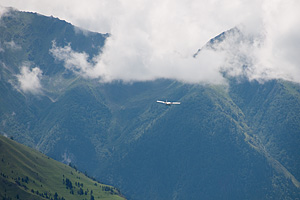
(Simikot, Humla, Nepal)
I was devastated. Given the timings if we did not manage to get to Simikot that day there would be very little chance of us getting to Kailash by another route, hence ending our once in a life time trip. We unpacked the bags from the plane (yes we were doing this ourselves) and stood distraught on the edge of the tarmac. However it was at this point that we got some more news, the plane circling Simikot had landed and we were going to take off again. However this proved too much for Anna's nerves. No-one could explain what was happening at Simikot so it seemed like a very arbitrary set of decisions convincing her that we were heading towards a rocky grave.
However it turned out to be a spectacular trip, skimming over the tops of high mountain passes and crossing narrow valleys, some populated, some completely inaccessible. Whilst there was some clouds on the ridges the valleys were completely clear and as we approached Simikot we got our last surprise, a very steep descent followed by a landing on a dirt runway.
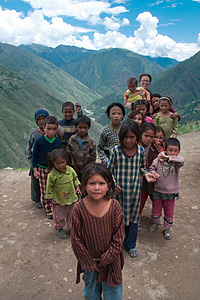
(Simikot, Humla, Nepal)
Simikot is an idyllic spot, situated on a broad plateau 3000m up on a spur overlooking the Karnali River. It looked small but once we start walking around the village it became clear that it had a population of over a thousand making it a major metropolis. Crucially it has a tiny runway which cuts the town in two. The plane was unloaded quickly and we headed up to our hotel. The somewhat alarmingly named "Sun Valley Resort" turned out not to be a Casino but a couple of imposing stone and timber buildings. Our room was spartan with bare pine floorboards but spotlessly clean and had a terrific view out over the runway to the mountains.
We decided to get some acclimatisation in straight away and headed for a walk around the village with Rikzin, who himself was a Tibetan born in a neighbouring village. Once out of the slightly muddy main drag the walk was delightful, the path hugging the lip of the plateau passing a series of small farms. After about an hour we got to the furthest point of our walk, a small gold roofed shrine on a bluff at the end of the plateau.
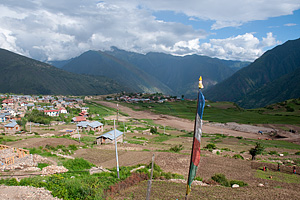
(Simikot, Humla, Nepal)
As we approached there were yells of excitement and it became pretty clear that the shrine doubled up as the local playgound. We were at once encircled by children asking us what our names were, then the names of our fathers, mothers, brothers (which we have none of) and sisters (which Anna has one of). We had a quick look around the headed back towards the village with ten children in tow. Before the airstrip we turned off the path and headed towards another bluff, this time just below the hotel overlooking an upstream section of the Karnali. Here we sat for a while watching vultures circle on the up draughts from the sheer slope below us.
We did not stay long as lunch was being prepared for us back at the hotel. We had a bit too much sun on our walk around town so decided to eat in the hotel's restaurant which was beautifully decorated in Tibetan designs rendered in primary colours. The rest of the afternoon was mainly relaxing at the hotel and taking in the panoramic view. The big event was a brief shower of rain and accompanying rainbow.
That evening we were treated to a show. A couple of Dutch NGOs had just finished a three week trek following the same course as we would to Kailash but taking the more gruelling route back to Simikot through the Limi valley. They were set on having a party with their guides and porters so had invited them all to the hotel restaurant where they drank Chang, sang Tibetan and Nepali songs and danced. We thought we would have an early start the next day so excused ourselves early. This turned out to be a mistake because the village dogs barked half the night so it took about an hour before we finally got to sleep.
Thursday, 23 July 2009
Dharapuri, Humla, Nepal
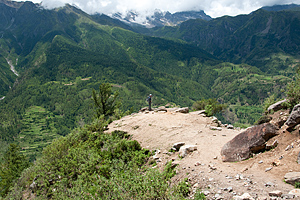
(Simikot, Humla, Nepal)
Getting going took rather longer than we had predicted. We sat outside the hotel in the morning sun whilst the weight of bags was guessed, donkeys loaded, unloaded then reloaded. We got going at 11am having to do one of the hardest parts of the trek in the midday heat. You ascend the mountains behind Simikot to 3200m but then immediately descend to 2000m, which is very tough on the knees.
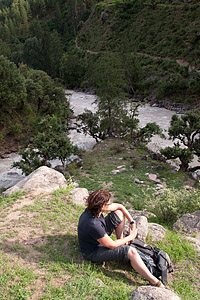
(Dharapuri, Humla, Nepal)
The scenery was quite surprising, lush green forges with the occasional deodar forest. We slowly worked our way down until we finally reached the lowest point on our trek. Here our guide had mentioned having lunch but when we got to the appointed spot we found that it was a very poor village and we were asked to sit on the roof of the shop, the only clean place, which meant we had the entire village watching us. Our cook had also cooked a range of curries for us which we really could not eat on such a hot day. We arranged that on subsequent days we would have just packed lunches so that we could eat them in the middle of the wilderness.
From our lunch stop it was just an hour to our campsite at Dharapuri. Here a large tributary joined the Karnali river and we found our tents and supplies and unloaded by the side of the river. Once the tent was set up we went for a walk and found a triangular patch of grass just at the confluence of the two rivers. We sat for a while but for some had forgotten our books so had to go back to the campsite. Here our attempts to read were hampered by flies, one of the penalties of camping so close to a village. We has dinner at 2000 and pretty much straight after went to sleep.
Friday, 24 July 2009
Campsite 2, Humla, Nepal
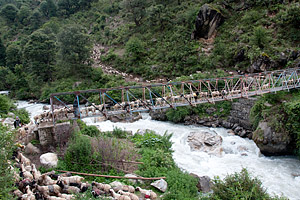
(Dharapuri, Humla, Nepal)
We woke up around 0630 and had breakfast, getting going around 0745. We were happy to start early as it meant we would get most of our trek done before the heat of the day. Whilst getting ready we stood and watched an endless procession of goats going across the box girder bridge opposite the camp. Walking out of Dharapuri we soon found ourselves just above an immense gorge cut by the Karnali. The path then took a turn for the dramatic as it became a rock cut channel in a cliff face suspended hundreds of metres above the river.
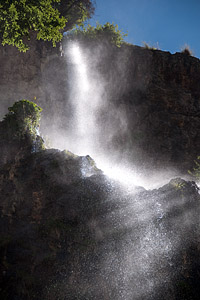
(Before Kermi, Humla, Nepal)
Following this walking along the gorge was flat and hot until we got to an amazing series of waterfalls spilling down from the top of the cliffs 100m above us. We stopped for a rest and cooled off in the shade before returning to the hot and scrubby path. Around twelve we got to a small village called Kermi where we stopped for lunch. We had arranged a packed lunch with the intention of eating it somewhere in the wilderness but when we got to Kermi we were very tired so gave in and again had lunch on the roof of the village shop. The view up and down the valley however was gorge-ous and this time the only audience was a homeless man who lived on the roof and was very happy to eat my unwanted boiled egg.
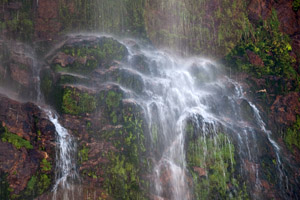
(Before Kermi, Humla, Nepal)
As we were about to leave our three horses and three donkeys caught up with us so we followed them for about an hour before we had another stop. This time it was for our entourage to have their cooked lunch. We had a guide and a cook which we were expecting. We also had also two donkey men who turned out to be very necessary as they often stopped the animals falling off the path. But in additional we had two cooks helpers who did the washing up at nights and early every morning went ahead carrying provisions and stoves on their backs to cook lunch for everyone else. We found this a bit unnecessary as people could have doubled up their roles and even given us jobs to do, however it gave employment to locals and they were very happy with the tips even though it was smaller as we had to divide the money we had taken with us more ways.
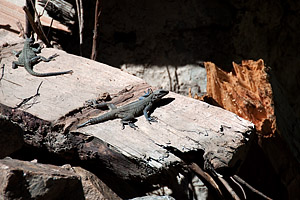
(Before Kermi, Humla, Nepal)
Anyway as usual they were cooking in a house by the roadside, as the stoves would not work in the wind. Thinking back on it I suspect it was the home of one of the cooks helpers as he lived in Kermi. However there was no view so we walked a few hundred metres up the road where there was one and sat down and soaked in the sun.After this stop the scenery was raised up yet another notch, we found ourselves walking along a contour through a huge deodar forest which covered a ridge at the confluence of the Karnali and a side river, Walking amongst the tall, centuries old pines with the river rushing below us was very atmospheric.
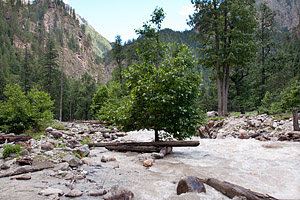
(Campsite 2, Humla, Nepal)
before long we got to our campsite which was a beautiful clearing in the pines about five minutes near vertical walk from a bridge crossing the Karnali. We were very dirty and sweaty so we dumped our gear and went to hang out at the river bank. This turned out to be the best option as despite looking idyllic the campsite was hot and their were again a few flies around. By the river we found a secluded spot and jumped in the freezing cold glacial waters. It was very much needed as after two days walking with no bath we were surprisingly grubby. We then sat and dried off in the sun whilst reading. Their were a few insects but most rapidly lost interest and left us in peace.
We returned to the campsite at around 1800 and then had another culinary extravaganza of Tibetan dumplings - Momos. After this we were again pretty tired so fell practically straight to sleep at around 2030.
Saturday, 25 July 2009
Yangar, Humla, Nepal
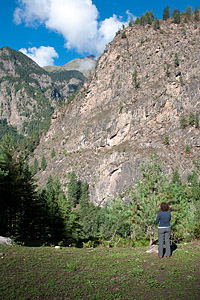
(Yangar, Humla, Nepal)
We work up around 0630 with the forest clearing totally in shade. As we had originally been scheduled to camp in Kermi, and we had gone a couple of hours beyond it to get to the more idyllic forest campsite, we did not have very far to go so were not in a rush. We packed up camp and got going around 0800. As we had so little distance to cover the cook, who spoke no English, accompanied us rather than the guide which suited us fine. We went back down to the river and then over a suspended bridge and carried on up the trail along the banks of the Karnali.
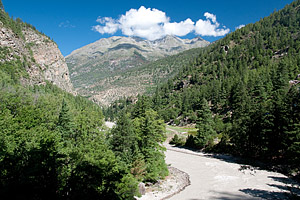
(Yangar, Humla, Nepal)
Here we encountered the first evidence of the road they were slowly building from Simikot to the Chinese border. All the locals we had spoken to was highly sceptical that the road would ever be completed. Speaking to the Dutch NGOs in Simikot they alluded to an element of politics. Building a road to the border would mean that the area would have better connections to China than it had to Kathmandu. In addition the politics of Nepal is dominated by the need to keep both of their massive neighbours, China and India, happy. India was apparently not happy about the road as it would allow the Chinese to get much closer to India. Thus there could have been an element of compromise, building the road to keep one happy but not building it fast enough to upset the other. However there were more obvious explanations for the slow progress, the terrain is incredibly difficult and a ten year long civil war could not have helped the effort.
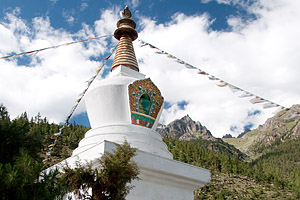
(Namkha Khyung Dzong, Humla, Nepal)
After dropping into a very narrow gorge we had to exit via a passageway chipped out of a cliff face about 200m above the river. Following this the valley immediately opened up and we dropped down again to walk through lush meadows at the banks of the river. We then climbed again to get to our destination, the towns of Yalbang and Yangar sitting next to each other at an altitude of around 3000m. We got to our campsite, a flat piece of land in front of the local school, at around 1100. We then had to sit around and wait until our horses turned up before having lunch.
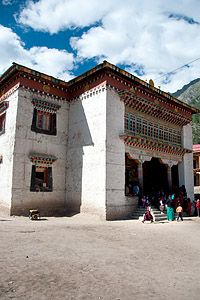
(Namkha Khyung Dzong, Humla, Nepal)
Fortunately, with half a day to use up, the villages are home to one of the largest monasteries in Humla the Namkha Khyung Dzong Monastery. The monastery had originally been located in Tibet but with the Cultural revolution in 1959 it had been demolished and the Degyal Rinpoche had been forced to flee. He slowly rebuilt it just across the border starting with an original building in 1985 and then refurbishing it ten years later. We were fortunate to arrive on the day of an auspicious puja where the monks were chanting from 0630 to 1900 and all the residents of the villages were inside it celebrating. We took our shoes off and went inside and then sat down to watch the chanting.
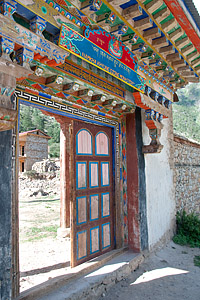
(Namkha Khyung Dzong, Humla, Nepal)
After a while I went out for some air and at this point was grabbed by a Tibetan and asked if we wanted some tea. Rather than a monk he turned out to be a teacher at a small school attached to the monastery who had also fled China. He led us up some very worn steep stairs to a room overlooking the main body of the temple where a couple of monks were tending hundreds of Yak butter lamp. We then went into a side room and sat and chatted with him and one of the monks whilst we were served with an endless supply of sweet tea.
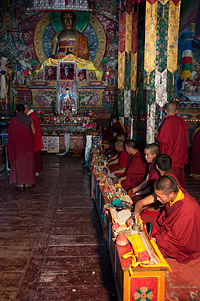
(Namkha Khyung Dzong, Humla, Nepal)
He told us quite a bit about the monastery. The most fascinating part of their situation was their proximity to the Chinese border. As a refuge the teacher did not have a Nepali passport so he would never be able to cross the border. However many of the monks were Nepalis so should technically have been able to cross the border to get supplies (as the locals did) but would be stopped as the Chinese ban the entry of monks to Tibet. This makes life difficult in an area where the closest and cheapest source of supplies is the town of Burang (Takalot) in China. It also meant that despite being tantalisingly close to the revered Mount Kailash and Lake Manasarovar the monks would never be able to visit.
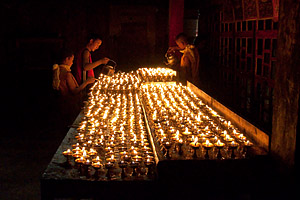
(Namkha Khyung Dzong, Humla, Nepal)
After this we had a look at the Monastery school which had a breathtaking location perched 300m above the Karnali with the 5500m peak of Dimochu overhead. Anna asked about the students and it turned out that between the Rinpoche and the governor of the state school (which were camped in) they were slowly winning the battle to keep children out of the fields and in the school to later ages. The impact of the traditions they were trying to combat could be seen in the numbers, the state school had about eighty students in its first grade but this dropped only about twenty in the second.
After the monastery we returned to the campsite and found a rocky bluff overlooking the Karnali to spend the remainder of the afternoon reading and writing. However as the afternoon Anna started to feel unwell with stomach pains and the shivers. this culminated in an attack of the "squitters" which was destined to last all night. I had similar but less pronounced symptoms but rather than skipping dinner to sleep and let the bugs work their way out, as Anna did, I persevered. I was rewarded with the spectacle of our talented cook preparing pizza using a steamer. My constitution however had its down side, when I got back to the UK I found I had Giardia, a parasite very common in Himalayan streams. Anna had probably flushed it out that night but I sadly kept on to mine and had to go on a week long course of tablets when I got back.
Sunday, 26 July 2009
Mota Gompa, Humla, Nepal
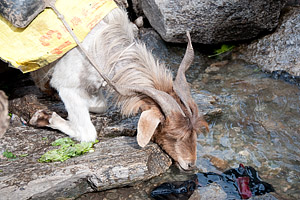
(After Yangar, Humla, Nepal)
It had been a night of interruptions so it was no surprise, with our tent pitched in the schoolyard next to the village water pump, that we got woken up at 0600 by locals turning up to do their morning ablutions. Truly this tap was the bathroom and kitchen for a large number of people: goat herders stopping on the route from China to Simikot; workers on the "road" camping out in temporary accommodation; locals and of course us. I exited the tent to the sight of a guy stripped down to his waist being scrubbed down by one of is fellow workers.
We were both feeling a bit dodgy so skipped breakfast and managed to set off at around 0730. There was a lot of up and down this day as we descended down to the river bed, then back up to avoid a ridge or a gorge. One notable problem was the presence of a lot of goat traffic. Rather than mules many traders go up and down the Burang to Simikot route with large herds of goats. Each one would have a miniature pack strapped to its back containing salt, beer or any number of Chinese products. I imagine that this made a lot of sense, given the perilous nature of the track only goats would be able to avoid loosing their footing and falling down into the ravine. However having thick coats it was not possible to use them past midday so every morning we would run into several herds and have to stop for ten minutes to let them pass.
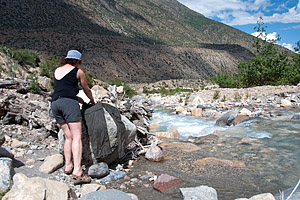
(Mota Gompa, Humla, Nepal)
The guide and rest of the crew decided to stop for lunch at 1030 in a charming pine forest just up from the gorge. We were dead beat so stopped but side stepped our packed lunch as we were still feeling a bit queasy. Again although the forest was nice they had insisted on stopping at a tea house with the consequence that the area was surrounded by manure. Although it was a bit distressing not to have lunch together we did our usual trick of walking a bit further and finding somewhere more hygienic.
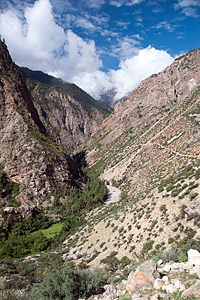
(After Yangar, Humla, Nepal)
After lunch we carried on trudging and just when we could not take any more got to the police checkpoint at Muchu . this was thankfully only about thirty minutes away from our campsite so we sat down at the village shop and had a coke. The owner's of the shop, really no more than a house, very nicely set some chairs up for us in the shade and Anna spoke to their baby whilst Grandpa looked on. There was a marked change in the people, you could tell they were definitely Tibetan from their faces and dress, whereas back down the valley there was more of a racial mix. Interestingly the baby despite being a boy was sporting an earring. The shop owner told us it was a Tibetan custom for babies that did not extend into adulthood.
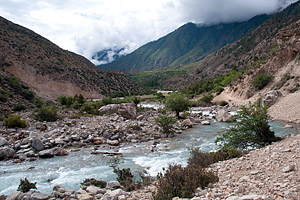
(Mota Gompa, Humla, Nepal)
Our campsite was at Mota Gompa, a dramatic location at the confluence of the glacial Kumachiya Khola and Karnali. Once we had dumped our stuff we decided it was time for our much needed twice a day bath so went slightly up a side stream and immersed ourselves. The water was crystal clear and we soon got over the intense cold by lying out in the sun. Unfortunately the valley we were in, though remote, was used by shepherds and I had the somewhat unnerving experience of being stared at by a shepherd for ten minutes whilst drying off in my underwear. I did not consider it offensive as we had seen many people washing in exactly the same way in the river so it must have just been the novelty value that piqued this guys interest.
Around 1700, having had our fill of the sun we returned to the campsite. In retrospect it was probably the nicest camp site of our whole trip. A small grassy field which a tiny stream had been redirected through, it benefited massively from a thorn barrier around it which prevented animals getting in - hence no flies. We sat down to read a bit more and observed that our party had grown in size. One of our cooks helpers had been joined by his wife when they had past their village a few days before however now there seemed to be two more characters. We had dinner around 1800, a feast of Nepali curry to celebrate our digestive tracts being on the mend.
Monday, 27 July 2009
Tharo Dunga, Humla, Nepal
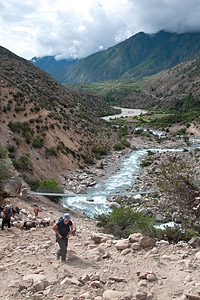
(Mota Gompa, Humla, Nepal)
We took slightly longer to get going but finally got under way around 0800. Crossing the Bumachiya Khola we had again to wait for a herd of goats to cross before us. This time however we were treated to a spectacle as a group of goats had decided they were going to cross the hard way. By the time we crossed the bridge one of them had managed to get stuck on a rock in the middle of the clear blue waters. We watched for a while and finally it slipped off the rock and was washed down the river spinning around a couple of times like it was stuck in a washing machine. Alls well that end well however, a bit further down it managed to swim to the shore and climbed up to be re-united with the herd.
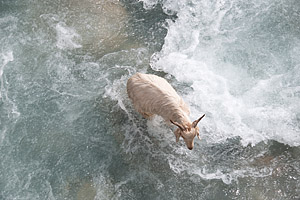
(Mota Gompa, Humla, Nepal)
Despite the regular interruptions by goat herds the going was pretty easy and we were to cover about 15km that day. For the first time we had left the Karnali which does a long loop through a near impassable gorge. Instead we were to climb up the clear blue Kumachiya Khola almost to its source then cross a high pass to rejoin the Karnali further up. After a few hours we finally got to a town called Yari where the scenery was spectacular, fields of buckwheat and mustard (well that's what the guide said) growing on terraced plains.
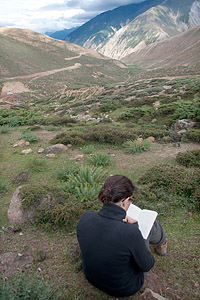
(Tharo Dunga, Humla, Nepal)
Another thing we saw at Yari was a bustling trade in salt. The route we were following has been used by salt traders for centuries. Originally they would bring the salt down from the Tibetan plateau to the plains of Nepal and would bring back other goods in return. Nowadays the trade went as far as a salt refinery in Simikot. At Yari we saw them repacking salt from the large sacks carried by the Yaks that took it over the pass into the tiny sacks carried by goats. It is astounding to realise how dependent we are on roads. Here we were in a series of valleys housing about 50,000 people where everything had to be bought in by animals in two or three day long journeys. It seemed like going back in time but in truth solar panels, radios and other modern appliances were amongst the goods we saw being carried around. The only real difference with this part of the world was that the terrain made road transport uneconomic.
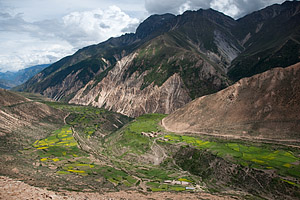
(Near Yari, Humla, Nepal)
After Yari it took us about an hour to reach the campsite. As we got closer the effects of trying to modernise the valley hit us in the form of huge dust clouds being blown up from the partially constructed road which we had been following and was now zig zagging up the Nara La pass. When we finally got to the campsite about half way up the pass it was around 1500. It was a very dismal affair, a dusty ledge cut into the hillside with no clean water and only a good view to rescue it. Since the dust from the roads was swirling around the campsite we decided to do our usual trick and find a more restful spot. This was easy enough because as soon as we got off the main trail and into the scrubby vegetation the dust died off. We were able to find a grassy patch on which we could site, read and admire the view.
When we got back to the campsite disaster had struck, our test was full of dust. It was pitched slightly awkwardly but it seemed that the amount of dust in the air was such that it was seeping through the air vents. We had a bit of a panic but then came up with the stunning idea of spreading water around the tent to kill the dust. Then we just had to sweep out what was already in the tent, have dinner, then go to sleep in the hope we would not get inundated in the night.
Tuesday, 28 July 2009
Burang, Ngari, Tibet
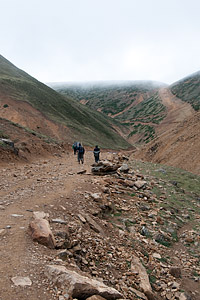
(Nara La, Humla, Nepal)
We did get inundated but with rain rather than dust. Since our tent was at least waterproof it had the effect of killing the dust and cooling things down a bit. We got up at 0600 to see everything veiled in cloud, then had breakfast during which a drama started to unfurl.
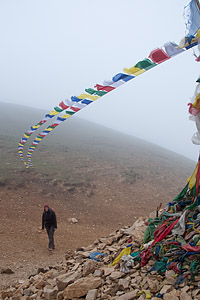
(Nara La, Humla, Nepal)
Every evening the donkey men would set the animals off in a direction to graze and then in the morning attempt to find them. This system sounds crazy but it worked as they generally did not go too far. However that morning they were nowhere to be found and the donkey men had already been looking for two hours by the time we had finished breakfast. A bit worried we never the less set off with instructions that, should they not be found, some more should be hired to take our rucksacks and camping equipment to the border.
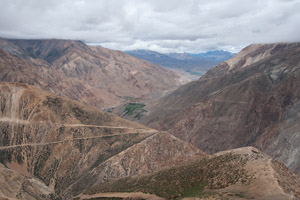
(Nara La, Humla, Nepal)
The pass was tough but not as tough as some we had experienced. It involved an ascent from 4100m to 4700m in the space of about two hours. The path was steep with a lot of dust, fortunately damp, and loose stones. However we slowly trudged to the top helped by the fact that it was overcast. We only stopped very briefly at the top and the descended. As soon as we got out of the clouds we had the most amazing views, the road itself had been scored through a landscape of barren eroded mountains. For about an hour we walked on ledges hacked out of vast landslides built up over centuries of winters and summers. Finally we got to a point where we could see the border and into Tibet itself.
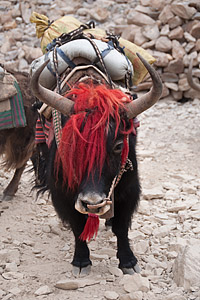
(Nara La, Humla, Nepal)
Its hard to explain, but although we had crossed many land borders in the past we had never trekked to one. Added to this the altitude which meant that we had sweeping views of the land we had trekked so hard to reach. I truly felt like the explorers of the mid nineteenth century who were sent by the Empire to explore a Tibet closed off to its British neighbours and largely unmapped. The most famous story of all is that of the Pundits, Indians trained by the officers of the Great Trigonometrical Survey of India to survey hostile territory. Disguised as pilgrims they would measure distances by counting beads on a special rosary and hiding the measurements inside prayer wheels.
Even though we could see it reaching the border was a different matter and it took us several hours of winding down the steep mountainside to reach the border town of Hilsa. Once there we had to sit around and see if the horses would turn up. We were left on the roof of a one storey hotel from which we could see the suspension bridge joining Nepal to China and frustratingly beyond this our jeep waiting for us at the end of a tarmac road. At this point we tipped and said good bye to most of our hordes. We would just take the guide and cook into Tibet with us, the remainder were apparently going to buy some goods at the border and make some money taking them back to Simikot.
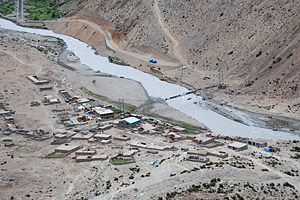
(Hilsa, Humla, Nepal)
We knew the border shut down around 1600 Nepali so as the time approached this we started to get a bit jumpy. Our guide crossed the suspension bridge to talk to the Chinese authorities and our jeep driver. But then suddenly he started running back, our horses plus rucksacks and cook had appeared out of the mountains not one second too late. It transpired that in the night the horses had gone all the way up the pass and then descended to a lower pasture on the other side. This meant our donkey man had to cross the pass three times, once to find them, another to get the horses back to the campsite and a final time to bring everything to us. I felt very sorry for them but with hindsight it did seem like an odd system to let them roam free each night.
The Chinese border crossing was the oddest we had ever been subjected to. We were met on the other side of the bridge by a soldier and an officer who spoke English and sported a patent leather briefcase. He then inspected our rucksacks for pictures of the Dalai Lama then jumped in our jeep with us to go to the nearest town Burang, 25km away. Once there we drove to a customs building where we filled out some forms and then had to stand with a thermometer under our armpits for ten minutes to check for Swine Flu. Finally we had our bags x-rayed and only then were allowed to go.
We checked into the hotel, which was a bit grotty, then wandered around town with guides. Rikzin spoke Tibetan but not Chinese so we had acquired Tse Wang, another guide to guide him. He turned out to be totally useless as amongst other things his English was pretty poor. Our first experience was going into a Chinese restaurant in Puramg and attempting to order. He could not recommend anything or translate anything so in the end we ordered the only dish we ourselves knew the Chines for, Mala Nuroh or Spicy Beef. We could see that our time in Tibet would be interesting.
Wednesday, 29 July 2009
Lake Manasarovar, Ngari, Tibet
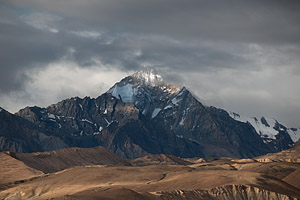
(Burang, Ngari, Tibet)
As predicted it was difficult to get going the next day. We were up before 0800 but no-one else was. Part of the confusion was around Bejing versus Nepali time. The whole of China follows Bejing time but since Tibet is so far West this becomes highly impractical as its still pitch dark at 0730 Bejing time. So no-one was around to get our passports to apply for our Kailash trekking permits. We hung around and eventually Rikzin appeared however he had no clue where the Tibetan guide was and we needed him to talk to the officials. We had some breakfast then went for a walk finding a beautiful old irrigation channel just outside the depressing main drag of the town. We also found a monastery with a series of caves carved out of the rock although we did not have time to explore that.
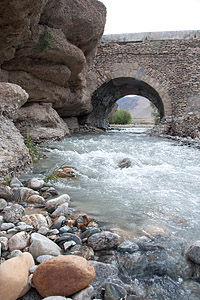
(Burang, Ngari, Tibet)
We finally returned to the hotel about 1100 Bejing time at which point we finally found Tse Wang, relinquished our passports and went to pack our bags. I think we got going around 1300 at which point we made an executive decision to all operate on Nepali time as it was much less depressing - by Nepali time it was only 1130.
The drive up to Lake Manasarovar was stunning. The landscape was one of endless blue skies and sculpted plains in a range of colours. After almost an hour of travelling along a perfect tarmac road we got to the next door Lake Rakshastal. This was an amazing shade of blue and dotted with a few islands. Unfortunately I left taking a picture until the official viewing spot so my pictures do not do it justice.
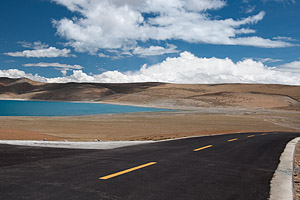
(Lake Rakshastal, Ngari, Tibet)
After Rakshastal we had to take the jeep off road to get to our camp site at Trugo Monastery by the shores of the lake. This proved to be exciting taster of what our journey back to Kathmandu would be like with the jeep cutting through streams and bumping along. At one point we found a herd of Kiang or Tibetan Wild Ass. Sadly I was not quick enough to get a decent photograph before they all ran off.
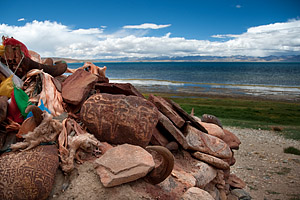
(Lake Manasarovar, Ngari, Tibet)
After about an hour we arrived at Trugo Monastery. This proved to be an almost perfect place to camp with views of Mount Kailash across the lake, endless shingle beaches to walk on and Gurla Mandhata behind us which at 7700m is the 34th highest mountain. We had just come to camp for a couple of days to acclimatise at 4500m in preparation for our Kora of Mount Kailash however it was such a magical spot that it was truly one of the highlights of the trip. Sure there were a few insects in the marshes on the shore but once you knew to avoid them it became almost like paradise.
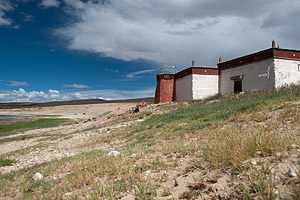
(Lake Manasarovar, Ngari, Tibet)
We had a small lunch then visited the monastery, there was not much to explore but just a very peaceful place to sit for a while and photograph Kailash as it disappeared in and out of cloud.Inside the monastery we took a peak in the central chamber. It had as you would expect an amazing view of Kailash to sit and contemplate, however what was rather creepy was that even though none of the Gelug Sect monks were there they had left their robed and hats in situ and these stayed up of their own accord. As a result it looked like the monks had all crumbled to dust many centuries ago.
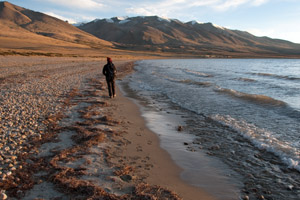
(Lake Manasarovar, Ngari, Tibet)
After this we then headed the other way from our camp, about an hour up shore to a point where there were no marshes and just beautifully remote shingle beaches. Here we dipped our feet in the lake, read and contemplated the views. One of the remarkable things about this region of Tibet is that until the 1920's no European had ever set eyes on it. There were rumours of a great lake at the heart of Asia which was the source of many of the continents great rivers which led many explorers to don disguises in an effort to visit the area. Whilst the area was eventually mapped by the time the Chinese annexed Tibet in the 1950s only a handful of Europeans had visited it and then it was completed closed off until the 1980s when China finally started letting Indian Pilgrims visit the lake and mountain.
Anyway sitting by the beach with no-one around (not one single person passed us in two hours) it felt like we were very privileged. We watched the sun set then had dinner and went to sleep.
Thursday, 30 July 2009
Lake Manasarovar, Ngari, Tibet
We woke up that morning to the site of Indian pilgrims wrapped in layers of clothing and sporting woollen balaclavas going to the shores of the lake to bathe in the waters. The Indians suffered in the cold having come from much hotter climes however were prepared to make the sacrifice of getting into the lake, something we had not dared to do. Talking to them they had a similar trip to ours hiking over the 5300m Lipu Lekh pass from Northern India to Burang.
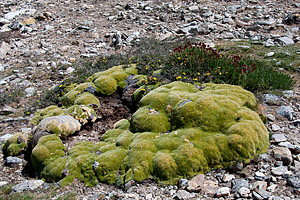
(Lake Manasarovar, Ngari, Tibet)
We were meant to spend the day acclimatising but rather typically for our guides nothing had actually been planned and they seemed to be content to sit by the shores of the lake. We decided to head up the slopes of Gurla Mandhata behind our camp to keep our legs in order. Since we had a shortage of clean water, the lake being a bit salty, we decided to make our goal the source of the rather muddy trickle which supplied the Monastery with water.
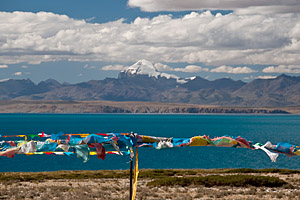
(Lake Manasarovar, Ngari, Tibet)
It was tough work not least because by the time we got to the source of the stream, where we could guarantee the water was clean, we were just below 5000m. However we well rewarded for our troubles. Firstly the source of the stream was a magical place, an alpine meadow covered with flowers and cushion plants. To top this the cloud above Kailash lifted and we had stunning 180 degree views of the mountain and the lake. We pumped some water, slightly enlarging the pool where the water trickled out of a rocky bed, then had our lunch whilst taking in the view.
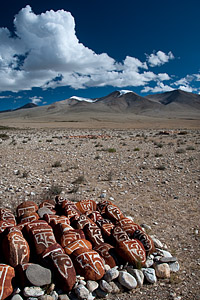
(Lake Manasarovar, Ngari, Tibet)
After lunch we had one last mission, to break the 5000m barrier, so we stumbled a bit further up the slope where we were rewarded with a view of Rakshastal. We also got a glimpse of a gazelle. Being that far up Gurla Mandhata put us in a select club, the mountain has only been successfully climbed six times. At this point we went a bit insane and decided to head to the ruins of Niego monastery some distance from Trugo. I guess this was the effect of having the binoculars, we had been looking at all of the sites around the lake from out lofty view point and had decided it would only be a short detour to go to Niego on our way back. This turned out to be a complete miscalculation. Getting there involved a two hour cross country hike and although the barren terrain meant you could literally hike straight from point A to B what we had not spotted was a large channel which bisected our route. Descending into this and ascending added an extra twenty minutes to our journey.
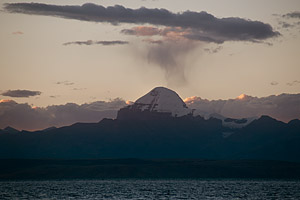
(Lake Manasarovar, Ngari, Tibet)
The monastery itself, destroyed during the Cultural Revolution, was definitely worth the trip not only for the monastery but the hundreds of red mani stones which had been placed there. Then we had about an hour's hike back along the shore of the lake. Again the desolate lake shores and the views of Kailash were wonderful but we were a bit too tired to fully appreciate them. Finally we got back to camp, watched the sunset, had dinner at 1930 and went to bed, tired but happy.
Friday, 31 July 2009
Darchen, Ngari, Tibet
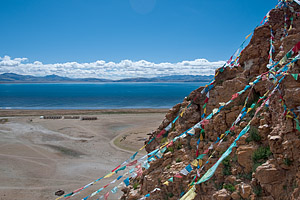
(Darchen, Ngari, Tibet)
I woke up at 0500 in order to see the sunrise but yet again Kailash was clouded in so I went back to sleep. We had arranged to leave at 0800 so packed our bags up and helped pack away the tent. Manasarovar had been a perfect place to camp but we were keen to move on an see some more of Tibet.
We drove off road back to the main highway seeing a Tibetan Gazelle or Goa and a giant hare. We had seen a Goa lurking around on the slopes of Gurla Mandhata but had not known what it was. It was amazing to see how much wildlife there was in such a desolate place. I suspect the lack of humans has preserved a lot of species and as a result it seemed like a nature reserve.
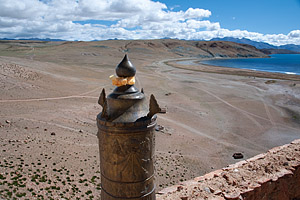
(Darchen, Ngari, Tibet)
The road took us to Chiu monastery where we got out for a look around. There were two subjects of interest here, firstly the monastery itself which was virtually carved from an outcrop of eroded red rock. We walked up the road which round the rock and found a small shrine at the top where four monks beat out a rhythm on huge drums whilst the others chanted and occasionally blew on Tibetan horns. However the real item of interest to me was the Chiu itself, a small brackish channel connecting Manasarovar and Rakshastal. Since water very infrequently flows through this channel its existence was under debate for many years and as a result there had been doubt as to whether Manasarovar was the ultimate source of the Sutlej river.
After Chiu we went to Darchen. Here we had been forewarned of what would happen so had a plan. We pulled into the compound of a hotel which was so feral it actually had a smashed toilet sitting outside its front door. Inside conditions were not much better, the room we were shown was "en suite" however the bathroom had been sealed off as some sort of bio hazard. We told the Tibetan guide that we were not staying there and to sort something else out, not unreasonable given how much we had paid.
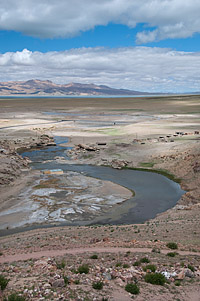
(Darchen, Ngari, Tibet)
This had the desired effect and after a bit of posturing we were driven to what is undoubtedly the best hotel in town, a small number of rooms maintained by a Swiss Hospital Mission. The rooms were in a very traditional style, each room having beds and a dresser painted with the swirls typical on Tibetan woodwork and a frieze i primary colours running round the top of the wall. Washing was also very traditional, each room having a supply of hot water in a thermos and a bucket of cold water. You filled up a bowl mixing them to achieve the desired temperature then washed yourself. It was very much the pre-cursor to plumbing. Having never done this before I can say that you need to have a plan for washing the soap off yourself before you lather up! The other great thing about the hotel were the views of Gurla Mandhata and the flat Tibetan plain from the Hotel's restaurant.
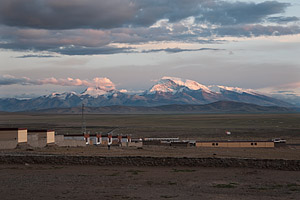
(Darchen, Ngari, Tibet)
After some excellent momo's in the restaurant we set out to explore Darchen. This did not take very long as it is what is best described as a frontier town. It has a dusty main road with a variety of shacks selling tourist artifacts. Anna had decide to buy a Tibetan necklace so found a shop where the prices seemed reasonable and they were open to a bit of haggling. The necklaces were of red coral and turquoise so it was impossible to tell what was fake. We decided to set a budget of 100 Yuan and stick to it.
Later on we had dinner in the hotel and chatted to its managers, a charming Swiss couple, the dining room being a very communal affair. They told us a lot about the Tibetan Medical and Astro Institute as it is known, how doctors were trained in a mixture of modern and traditional medicine and how there was also a small factory making traditional remedies. The hotel had started as a sideline with profits going to the mission. However it appeared that with rest of the accommodation in Darchen being so poor they definitely had the makings of a good business.
Saturday, 1 August 2009
Shiva Stal, Ngari, Tibet
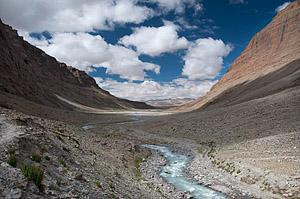
(Kailash Kora, Ngari, Tibet)
The first day of our trek around Mount Kailash. We had a relaxed breakfast in the hotel and set off around 0800 Nepali time. It turned out that we were cheating a bit on our Kora as the jeep would drive us to a place called Darboche, about 8km from Darchen and the place where yaks tend to be loaded. From a Kharma perspective I am sure we were missing out a bit but from a landscape perspective we were not at it was all very similar to Darchen.
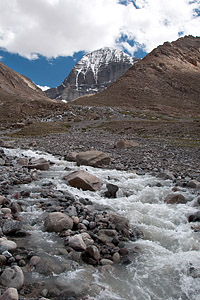
(Kailash Kora, Ngari, Tibet)
Anyway we said goodbye to our driver N'Duge and swapped him for Bemma the Yak Man. The items needed for three days were loaded on a yak and the we set off. The trek is quite unique even without its religious significance. You start walking through a series of broad river valleys surrounded by weathered rock faces. After a couple of hours you start to get your first glimpses of Kailash which stays with you until the Dolma La pass on the second day.
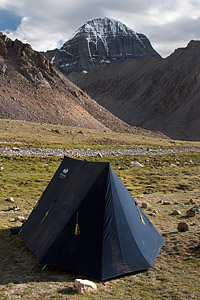
(Shiva Stal, Ngari, Tibet)
As we went along we were passed by many Bönpo, adherents to a sect of Tibetan Buddhism who differ in that they circle Kailash in an anti-clockwise direction, as opposed to Hindus, Jains and all other Buddhist who circle it clockwise. Our guide suggested stopping at Dirapuk, however this would have left us with 1 600m climb the next day.So we negotiated stopping at Shive Tsal halfway up the pass. When we got to Dirapuk we both rejoiced at and regretted our decision. We were completely exhausted and out of breath however the camp site was so appallingly dirty we could not contemplate staying there and pressed on.
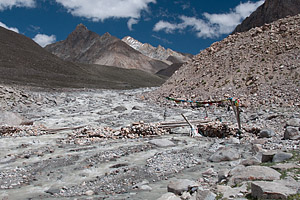
(Kailash Kora, Ngari, Tibet)
The scenery was stunning at this point, the North face of Kailash was comparatively free of clouds and below it a huge glacier melted away to form a river. We crossed this with the aid of a series of logs. Following this we had to climb a moraine which was heavy going as getting from 5000m to 5300m with 50% of the oxygen at sea level is not easy. However the effort paid off, Shiva Tsal was a lovely campsite. Grassy and rarely used it overlooked a stream and had a face on view of Kailash, Marmots run all over the site and our yaks looked very content. Undoubtedly it would be cold at night at the altitude however the view more than compensated.
We spent the last hour of sunlight out of the wind in the tent then watched the sun set on the mountain, The valley was plunged into shade whilst Kailash was lit up with golden sunlight, the effect was spectacular. Then we had dinner and retreated back to our tent as the cold was starting to set in.
Sunday, 2 August 2009
Zutul Puk, Ngari, Tibet
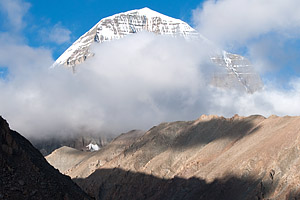
(Kailash Kora, Ngari, Tibet)
The second day of our Kailash tour and the most challenging. I had not slept very well due to an indecisiveness about whether to wear my fleece or use it as a pillow. I had gone with the former but this resulted in a mind numbing neck pain which woke me up at 0100 at which point I realised it was not that cold in the tent so swapped round. However by then the neck pain had taken root and although I managed a bit of snoozing when we finally woke up at 0600 I was far from refreshed.
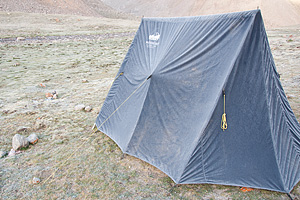
(Kailash Kora, Ngari, Tibet)
Outside the tent the world was transformed, white frost had caked the ground and the tent. Unfortunately Kailash was covered in cloud otherwise it would have made for an impressive photo. We had breakfast and set off around 0700am. It had been agreed because today we would be climbing the Dolma La pass, a climb up to 5600m followed by a descent of almost of a kilometre. The early start meant we had a good degree of cloud coverage reducing the pain of getting up there.
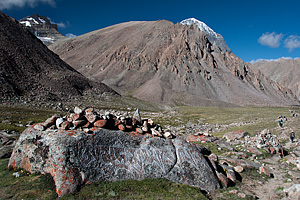
(Kailash Kora, Ngari, Tibet)
However the effort of trying to climb any amount at 5000m with 50% of the oxygen we sea level dwellers are used to cannot be underestimated. We had to go very, very slowly and did not reach the summit until 1000. Cheering us up were the chants of the Tibetans. It seemed that large amounts of Bonpo must have gotten up at an unreasonable hour to be coming down the pass just as we were ascending. As we passed them each greeted us with a cheery Tashi Delek - "Hello" in Tibetan.
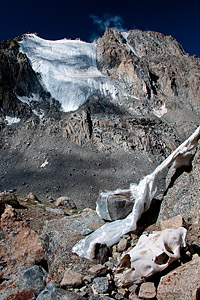
(Kailash Kora, Ngari, Tibet)
The top of the pass was both glorious and upsetting. The amount of rubbish that had been jettisoned was extreme and included a wide variety of items from mini juice boxes to aerosol cans which had once held oxygen. However we attempted to ignore this and set ourselves the task of securing some prayer flags which Anna had bought up with her. They were in good company, the entire site was covered in them.
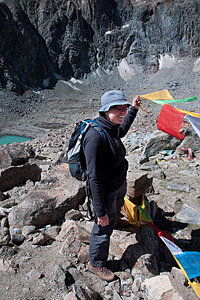
(Kailash Kora, Ngari, Tibet)
The descent from the pass was steeper than the ascent and consisted of three steep moraines in quick succession. However after a couple of hours we found ourselves on the valley floor of the Zhong Chu, the river that would take us back down. We had a lunch in a lovely alpine meadow of flowers and then started the lengthy walk towards where we had agreed to camp. This took us round a series of bends but thankfully it was a very consistent descent. One drama occurred at a river crossing, In order to conserve time we had agreed to cut across the river and back again. However on the return crossing Anna steadfastly refused to follow the guide and I, and without anyone to assist her fell in the river. She then proceeded to wade across to our side getting very wet in the process!
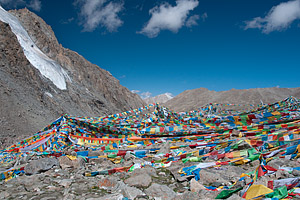
(Kailash Kora, Ngari, Tibet)
When we finally got to our camp at about 1500 two dramas ensued. Firstly the Tibetan guide had failed to camp where we had agreed. He wanted to camp near the guesthouse at Zutul Puk Monastery, we did not as we knew it would be surrounded by rubbish, so had agreed to camp a kilometre before. Sure enough when we arrived our tent was pitched by the river surrounded by broken bottles with a pleasing view of a mountain of rubbish.
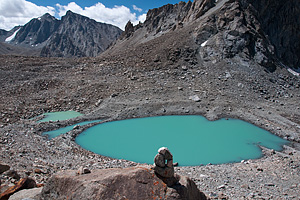
(Kailash Kora, Ngari, Tibet)
However we never got to find out why as we arrived to find him dripping in blood. After some questioning it turned out he had been using the Yak Man's dagger to strip some meat off a bone and had cut severely into his thumb. We did not have any bandages in our medical kit so I told them to get some cotton and apply pressure to the wound. Nobody wanted to sacrifice any garments so instead came up with the rather crazy idea of applying a tourniquet with a piece of string. When it was finally explained again the cook grudgingly came up with a table cloth , we ripped some off and bound it. We then sent him back to Darchen, telling him to walk with some pilgrims. It was a deep cut but not life threatening however the risk of tetanus meant he needed to get some treatment.
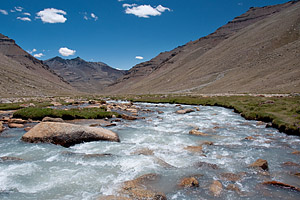
(Kailash Kora, Ngari, Tibet)
The whole episode highlighted the immaturity of Tse Wang. He was about as useful as a chocolate frying pan, only springing into life when we had one of the frequent police checks. It seemed his one skill was speaking Mandarin and his English was so broken that the few times he tried to offer us any insight we could not understand him. Whilst I understood the tourist infrastructure in Tibet was very new I had no idea to what purpose he had been sent with us.
Anyway after resolving the severed thumb incident we retired to our tent to escape the sun and wind. This seems pathetic but Tibet is one of the few places on Earth where you can freeze and burn at the same time, so the minute the amazing views stop changing the instinct to shelter kicks in. We had a quiet dinner after the sun set and then went to sleep.
Monday, 3 August 2009
Mayun La, Xigaze, Tibet
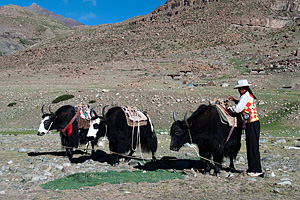
(Zutul Puk, Xigaze, Tibet)
The final day of our trek around Kailash.In reality we could have completed the trek in two days. However the last three hours of the trek proved to be pretty special and it would have been a waste to undertake them dog tired after the descent from the pass. The route proceeded down the river past meadows until the river plunged into a gorge which we walked along the lip of.
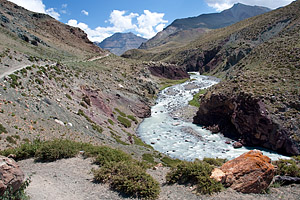
(Kailash Kora, Xigaze, Tibet)
The interesting thing was the lack of pilgrims. I personally thought this was because it was a Monday, the pilgrims having compressed the walk into a weekend stroll. Whatever the reason it was wonderfully quiet and the views spectacular. The rocks around the gorge were a riot of colour, at one place strips of purple rocks sat next to strips of orange and green. There was also some wildlife, I even spotted a Hoopoe, a pink bird with a crest and black and white wings.
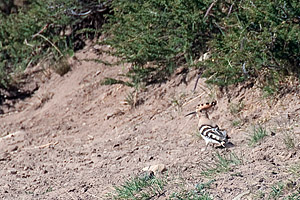
(Kailash Kora, Xigaze, Tibet)
We exited the gorge to find the jeeps waiting for us. Our driver and another jeep to take Fun-Juk, the cook, back to Burang as he was not going with us to Kathmandu. Instead he was joining another group returning to Simikot. We said goodbye to him and our Yak Man Bemma, picked up the juvenile guide Tse Wang (his thumb now bandaged) and set off to camp for the night by lake Manasarovar
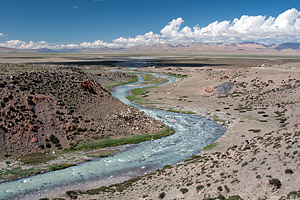
(Kailash Kora, Xigaze, Tibet)
However when we got to the designated spot we found that rather than being by the lake shore it was miles away in a dirty area very close to a small village. It started to seem as if the "standard" route back to Zhangmu at the Nepal border was very badly thought out. The next stop would normally be Paryang which our guides had reliably informed us was a mosquito and dog ridden hell hole. The fact that they were not exactly selling the itinerary made us wonder what we were paying for here, a bit of planning beforehand would have established a route everyone would be happy with however they did not even have a roadmap. However with a bit of drawing in the dust we worked out a plan with them. As it was still early in the day we would carry on to a point half way between Manasarovar and Paryang and in this way shorten our return journey to Kathmandu by a day.
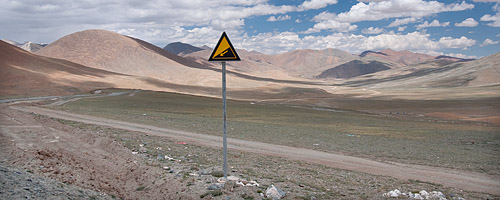
(Kailash Kora, Xigaze, Tibet)
Despite the disappointing campsites the journey was epic. We ascended to the source of the Tage Chu, one of the rivers which fed the lake, and then crossed a plateau to find Gung Gyo Tso and then ascended the Mayun La pass to almost 5000m. Just after the pass we found a small valley with a stream in it. This was the Mayun Chu, one of the sources of the Tsangpo River which after an epic 2,900km journey, including a near 360 degree turn through the Himalayas and travelling through the world's deepest canyon, empties into the Indian ocean as the Brahmaputra. So difficult was its course to trace through the Himalayas that as late as the nineteenth century the connection between the two rivers was a subject of debate. Indeed the river was not fully explored until 1924 when the botanist Kingdon Ward abseiled into the 5,400m deep Tsangpo canyon.
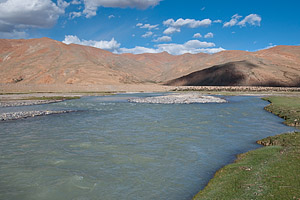
(Mayun La, Xigaze, Tibet)
We stopped here to camp by the banks of the Tsangpo. Whilst completely unpromising looking at first the campsite proved to be a real gem. We spent the afternoon dangling our feet in the Tsangpo and reading. It was idyllic and so peaceful that the big event of the afternoon was shepherds bringing three huge flocks of sheep down from the mountains to graze on the opposite bank of the Tsangpo.
That evening we had a treat. The campsite was next door to a small roadside shack. When we went inside we found a very cosy room with several sofas with rugs thrown over them and a large yak dung burning stove in the centre. Our guides had started drinking Chang a couple of hours beforehand and Tse Wang was already drunk by the time we got there. As we sat down the place started to fill up with the local denizens, mostly shepherds wrapped in layers of clothing that they peeled off as they started to warm up. The atmosphere was very friendly and the proprietor of the place prepared a stew for us whilst our guides entertained her six month old baby. The food was pretty decent and we went to bed more than a little drunk.
Tuesday, 4 August 2009
Saga, Xigaze, Tibet
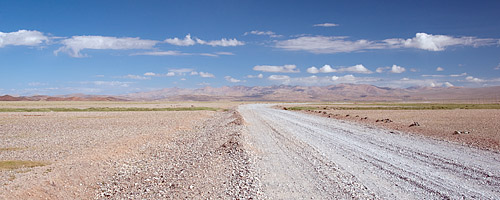
(Paryang, Xigaze, Tibet)
We woke up around 0660 Nepali time. I had a wash in the Tsangpo before packing our kit up and heading over to the shack for some tea. We then headed on our way. Today was to be quite a lot of driving. The road connecting Kailash to Lhasa is completely un tarmaced, although it is relatively flat and has bridges at all the necessary places. It was also being rebuilt and eventually will be completely surfaced, however this meant that many sections were dug up and we had frequent detours.
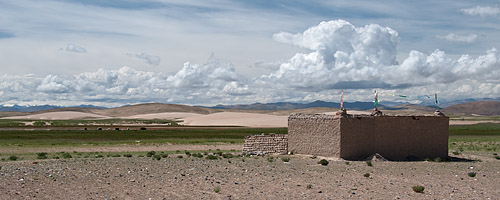
(Paryang, Xigaze, Tibet)
From Mayun La we descended following the Tsangpo, past another stop at Nori Funzen to Paryang. The location of Paryang is scenic with large expanses of grassy marshland interrupted by anachronistic sand dunes at regular intervals. However the town itself was as bad as our guides had made out. We stopped in the middle of town which was not much more than a couple of shops and a large number of vehicle repair shops. The first thing that happened was an urchin attempted to put a can under one of the wheels of the jeep, presumably in an effort to puncture it. Then we went us into a supermarket where they attempted to overcharge us so we decided to just leave.
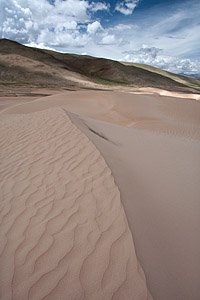
(Paryang, Xigaze, Tibet)
The journey after that took us through scenic valley after scenic valley. We climbed up through some sand dunes and got out to have a run on them. Later we then stopped off for lunch at a monastery town called Zhongba. We found a Sichuanese restaurant and with literally no help from the guides I managed to tease a passable Kung Po Chicken out of them. After lunch we visited the monastery, which was closed, but had a stroll around its various Gompa's all of them surrounded by masses of yak skulls.
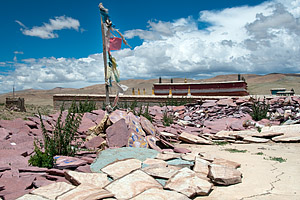
(Zhongba, Xigaze, Tibet)
After this we descended into a series of very green valleys that were reminiscent of places in Scotland. Here I singularly failed to stop the jeep and take photos of a very atmospheric ruined castle. Then we ascended to a high pass besides some spectacular snow capped mountains. We stopped for a while at the top before descending to find ourselves in the valley leading to Saga, our destination for that night.
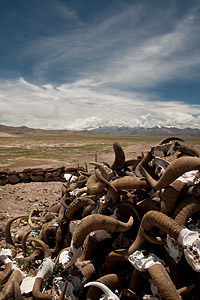
(Zhongba, Xigaze, Tibet)
Whilst the environs of Saga are quite pretty the town itself is the usual mess of dirt tracks and half abandoned office buildings of a West China county capital. Here we phoned our hotel in Kathmandu to explain we would be arriving a day early. We then sat in a Tibetan tea house drinking butter tea, reading, writing and generally just passing the time until dinner.
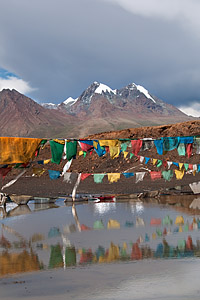
(Saga, Xigaze, Tibet)
Dinner was good but not that great. In retrospect we should have bought a Chinese phrase book with us but we had not as we expected our guides to be recommending dishes etc. The reality was that as soon as we got into a restaurant Tse Wang would only order the most basic items. To combat this we would try to get him to read the menu to us, which he could not as he did not have a good enough knowledge of English. This time we lucked out a bit and found there was a specialities section, and had a dish of very tender pork in a soup.
Then it was back up the valley that led into Saga and where we were to camp for the night. We did little apart from park the car, put the tent up by the headlights and then go to sleep.
Wednesday, 5 August 2009
Zhangmu, Xigaze, Tibet
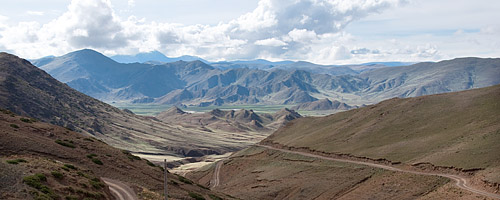
(Saga, Xigaze, Tibet)
Waking up at Saga we realised there were no facilities. The river that trickles through Saga was pretty Fetid even where we were and there was a gang of workmen digging a trench right next to the tent. It was clear that my quick dip in the Tsangpo the morning before would be my last wash before we reached Kathmandu. We packed our tent up and got underway quickly.
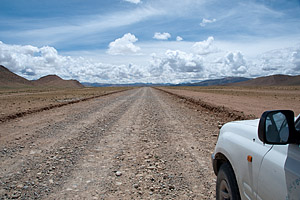
(Saga, Xigaze, Tibet)
This was to be the most scenic and dramatic of our days in the jeep. We separated from the Tsangpo and the Darchen to Lhasa road and headed through a valley to the South, climbing up a pass. Here the scenery was quite green but with very little sign of human habitation. In one valley we found a village where it had been raining the night before and a flash flood had wiped away the road surface. The villagers cheerful waved us down to another by now familiar diversion.
In the next valley we found the entrance gate for the Qomolangma National Nature Preserve, which surrounds the Everest area. Here our guide paid an entrance fee whilst the car was surrounded by hundreds of begging children. From here the landscape became more arid with a vast plain of dusty soil interspersed by tufts of grass and rocks. We followed the road upwards until we got to a pass by the side of a mountain and then descended a river gully to the shores of Peiku Tso. here we did not stop as the main attraction, the view of the 8014m Mount Shishapangma was obscured by cloud.
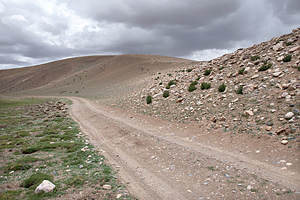
(Friendship Highway, Xigaze, Tibet)
We then followed one of the rivers which fed the lake upwards. Here we passed a handful of nomad tents from which women rushed out to beg from us. We asked our guide about it but were told that they were begging because their husbands were away tending to the yaks so there was nothing for them to live off. Eventually we reached another unique zone where arid sand and rock hills enclosed a very narrow, lush green river valley. Here we stopped for a lunch of stuffed Chinese dumplings which we had bought in saga in the morning.
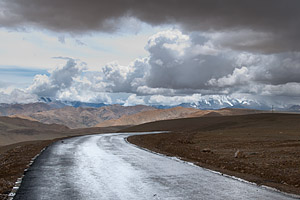
(Friendship Highway, Xigaze, Tibet)
After we had eaten I observed Tse Wang do a very disappointing thing, he took the plastic bag and chopsticks from lunch and stuffed them in a Pika burrow which he then stamped shut. I felt sickened that he had so little care for the environment especially in one of his countries national parks. However by this point I had realised that the Tibetans, as the owner of the Swiss hotel in Darchen had told us, had no Kharmic link to rubbish, Since rubbish was very new to their way of life they did not feel the need to dispose of it responsibly so just threw it in the fields and streets. Eventually like us they would, he asserted, feel responsible for the rubbish and start to care.
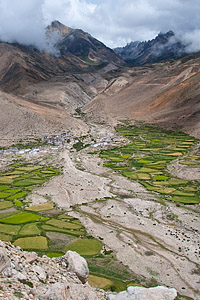
(Nr Milarepa's Cave, Xigaze, Tibet)
Getting back into the jeep we then climbed up to the top of the Tibetan plateau to meet the Lhasa to Kathmandu Friendship Highway. Here the weather changed dramatically for the worse. We were on the very edge of the plateau and humid air rising up from the Bhote Koshi valley met with the freezing cold air of the plateau to produce hail. We stopped at Lahung La, at around 5000m the highest point, to admire the view, a wall of Himalayas unfortunately wreathed in cloud with no chance of a gap.
We then plunged into the heart of the Himalayas following the Bhote Koshi down towards the Nepal border. It started out as a deep gorge utterly desolate with no vegetation. Then very suddenly it sprung to life with terraced fields of buckwheat and small villages. Here we were scheduled to stop at Milarepa's Cave just before Nyalam so pulled up at the roadside and followed a track downhill. Rater predictably the monastery was closed and worse was highly modernised with double glazing. The guide gave us some story about the monastery not being very popular but the truth was very obvious. Slightly downhill in the main part of town a huge festival was taking place and undoubtedly any monks would be at this.
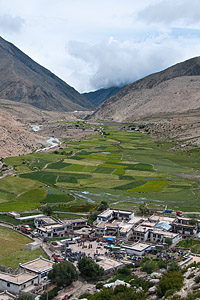
(Nr Milarepa's Cave, Xigaze, Tibet)
Despite the fact that our guides were not keen we descended the hill to look at the celebration. It was amazing, all of the surrounding communities had gathered dressed in their finery. Women had huge decorative metal plates around their waists and several men were dressed up in Tibetan dress. In the centre of the village square several men danced and acted out dramas. Everywhere kids ran around firing off cap guns. It was a very different side of Tibet that we had not seen before - happy, prosperous farming communities.
From here we plunged further into the Himalayas passing the district capital of Nyalam. As we descended below 2500m the vegetation started to get thicker and pretty soon we found ourselves in a remarkable jungle clad, deep gorge with wisps of cloud pouring down its sides. Every 100m or so a waterfall came cascading down the walls of the gorge adding to the incredible beauty of the place. However this vertical beauty came at a high cost as we were about to find out.
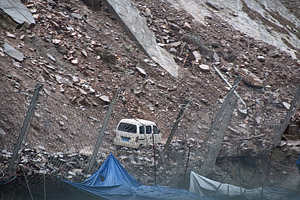
(Zhangmu, Xigaze, Tibet)
Pretty soon our jeep came to a complete stop as the road was blocked by a landslide which had apparently happened in the last hour. We waited for about half an hour then suddenly everyone came running back to their jeeps and we went through. However twenty minutes further down the road we came to another standstill, this time it all looked a lot more terminal. We were in a concrete landslide shelter with a waterfall belting down on top of it and spraying out into the gorge. Anna went out into the pouring rain to investigate. A huge landslide had taken place the year before and repairs were taking a long time. All that was holding the road up was some steel netting and we assumed they were holding back the traffic to help work on the road. In the end we stayed there for about an hour before the traffic re-started and we could trundle into Zhangmu.
From a distance Zhangmu looks picturesque. However up close it is a peculiarly unpleasant border town. Strung out along a series of switchbacks in the road as it makes its way to the valley floor its a very vertical city with numerous staircases cutting through its buildings enabling residents to transfer between levels. Masses of trucks come from either side to swap goods with their opposite numbers but with no flat land for a goods yard this means most of the roads are lined with trucks. The subtropical climate ensures that it rained all the time, and our guides assured us that it was permanently damp the year round.
We were dropped off at a hotel and here we were presented with yet another disastrous room. Damp was creeping up the walls and it had no window. After a bit of squabbling we got switched to a room upstairs which had no bathroom but at least was dry and had a view looking back into Zhangmu. After this we arranged to have a last meal together with the guides and driver. However Tse Wang declined the offer and for some reason the driver turned up but did not eat. We had asked to go to a Tibetan but were instead taken to a hotel where the far was a bit more international. I had a pizza which was actually quite nice. We then went to bed, there was no question of a final night party as the conversation had been rather stilted.
Thursday, 6 August 2009
Kathmandu, Bagmati, Nepal
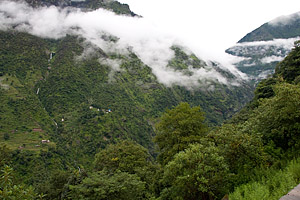
(Zhangmu, Xigaze, Tibet)
The next morning we sorted out our own breakfast and met the guides and driver at their Tibetan Cafe hang out, leaving around 0730 Nepali time. This sounds early but the Tibetan border operates on Bejing time so opens at 0700 Nepali. When we got to the border on the floor of the valley about 10km from Zhangmu we were at the end of a very long queue of foreigners waiting to go through. I would have been cross with our guides however I knew our jeep had set off at 0600 from Kathmandu so would not be there until 1030 at the latest. So being last through would kill some of this time.
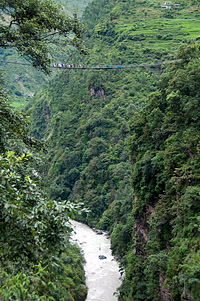
(Friendship Highway, Bagmati, Nepal)
The process was very slow as customs searched every bag and many of the tourists had come from Lhasa and had stuffed their bags with antique artifacts of every description. The customs officials inspected each of them to make sure they had no cultural value (i.e. they were modern fakes) before letting them through. Another unusual aspect of the border were the "porters". For a little money you could hire a porter to carry your baggage through customs and no mans land. Rikzin was forced to do this as he had the tents plus other assorted camping gear to get back to Kathmandu. However rather disconcertingly many of these porters were young girls and one even had a baby strapped to her front whilst she carried a large tote bag on her back.
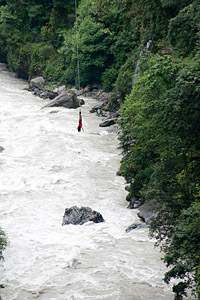
(Friendship Highway, Bagmati, Nepal)
The Chinese side was chaos set in a sparkling brand new building. The Nepali side however was chaos in a crumbling shack the other side of the "friendship bridge" which crosses the raging Bhote Koshi. However the good this is they had many clerks processing visa applications so we were able to clear the various steps much faster than on the Chinese side. Very quickly we were out with our Nepali entry stamps waiting for our jeep.
The jeep ride was a pretty lengthy affair as the number of twists, turns and landslides on the road to Kathmandu limits the speed to an average of 25kmph. We stopped a couple of times, once to witness bungee jumping at the Last Resort, a hotel with a suspension bridge 180m above the Bhote Koshi that westerners hurl themselves off. We also stopped for lunch and briefly when passing through a village with a Hindu celebration, part of which consisted of a road block of children with large sticks. Rikzin had to pay them off before we were let through.
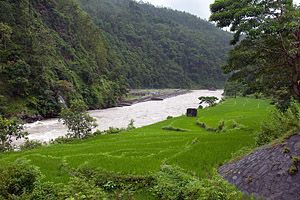
(Friendship Highway, Bagmati, Nepal)
A final note on the scenery. The road from Kathmandu to the border must be one of the most scenic road trips I have ever experienced. The road cuts through deep ravines surrounded by rice paddies to finally depart the river and rise to ridges where, in Spring and Autumn, you have views of snow capped Himalayas. It is a trip to be taken once in a life time but, since the border is such a hassle, I don't see ourselves doing it again.
We finally found ourselves at Bhaktapur on the outskirts of Kathmandu around 1430 and by 1330 were ensconced in Dwarikas with a beautiful room overlooking Kathmandu. The first thing I did was take a shower, the first since 29th July, nine days before. We relaxed before heading out to eat dinner at Fire and Ice, Kathmandu's best pizza joint and a welcome break from good, but endless, curries.
Friday, 7 August 2009
Kathmandu, Bagmati, Nepal
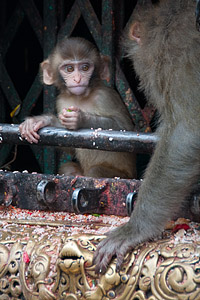
(Kathmandu, Bagmati, Nepal)
We had not planned to be back in Kathmandu so quickly so had an extra day to recover and see sights. The rains had come to Kathmandu and it had been raining pretty much continuously since we arrived. Nevertheless we decided to go and see Swayambhunath , otherwise known as Monkey Temple. This was enjoyable for its views over Kathmandu as its on a hill out to the west of the city. However it is not very fulfilling from a non-Buddhists perspective. There were no monks in sight however the whole complex of stupas was covered in pigeons, dogs and monkeys. Amusing as it was it felt more like a zoo than a spot for quiet contemplation.
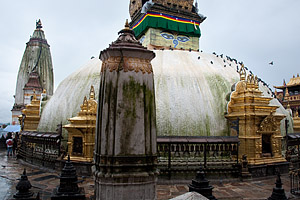
(Kathmandu, Bagmati, Nepal)
Following this we attempted to do some shopping near Pattan but failed to buy anything. We then returned to the hotel to read, write, pack and generally just relax at the hotel. That night we again had dinner in the hotel's excellent Newari restaurant and went to bed full to bursting point.
Saturday, 8 August 2009
Kathmandu, Bagmati, Nepal
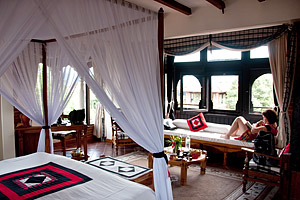
(Kathmandu, Bagmati, Nepal)
The last incident of our trip took place in our room. I woke up dimly aware of something moving across our room. I thought I had imagined it but got up and went over to the table and here found a banana skin. I then went to the window and looked out to see a small red monkey face peering at me from around the side of a carving. The only shock to me was to see how stereotypical monkeys are, there was a whole bowl of fruit yet the monkey went straight for the banana.
Anyway that was it, we got a taxi out to the airport and then jetted back to the UK.






